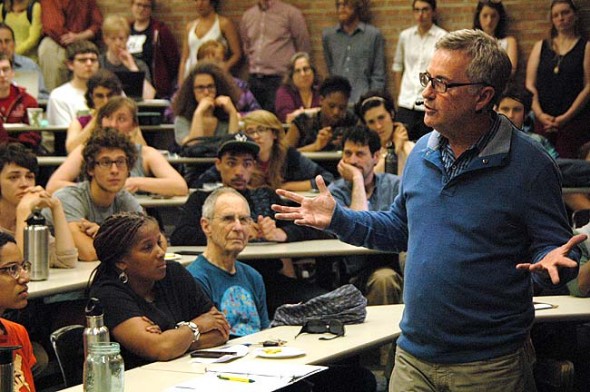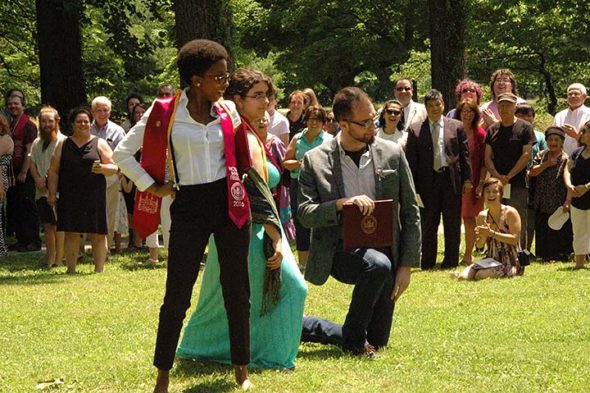
Mark Roosevelt, then Antioch College president, told the campus community he was leaving in 2015 after five years at the helm. (Photo by Matt Minde)
The Decade in Review: Higher Education
- Published: January 2, 2020
Antioch College relaunches
In 2010, Antioch College continued on its path as an independent liberal arts college, getting ready to welcome its first class in the fall of 2011. Mark Roosevelt was hired in the fall as the first president of the revived Antioch, and moved to town with his family in late 2010. Interim President Matthew Derr led the college prior to Roosevelt’s hiring.
In mid-2010, college leaders announced a $3 million bequest from former faculty Nolan Miller and his brother Dick Miller for the purpose of allowing Antioch College students to work with Yellow Springs nonprofits.
In late 2010, tensions with tenured former faculty arose regarding the revived college’s hiring practices.
Antioch College was fully up and running by 2011. In February, the first four students were accepted for the fall, and later in the spring, the college announced the hiring of its first six tenure-track faculty members. That fall saw the revived college’s first class of 35 students, more than anticipated.
Also in 2011, Roosevelt articulated a new mission of environmental sustainability, with a specific focus on food issues. In August, the college launched its first significant sustainability project, the Antioch Farm, on the college’s 35-acre former “golf course.”
Early in 2012, news of Antioch College’s tuition-free Horace Mann fellowships, extended to its first four classes, went viral. The college received more than 3,100 applications for 75 available spots, making it the country’s most selective college that year.
The class that arrived in the fall of 2012 was high-achieving and diverse. The college offered 44 classes taught by 12 full-time faculty and additional adjunct faculty.
Also in 2012, the college reached an agreement with Antioch University to pay $8 million to buy back public radio station WYSO and nullify the university’s remaining claims to the campus.
Antioch College had a banner fundraising year in 2013, with $19 million raised during its fiscal year 2012–2013 for a total of $50 million since it became independent of Antioch University.
The college’s annual operating costs were at about $12 million in 2013.
That summer, the college hired 11 new faculty members, bringing the total full-time faculty to 29.
Construction started over the summer of 2013 on a new $7.2 million renovation of the gym, which became the Health and Wellness Center. A $1.2 million renovation to the theater building also began.
The size of the Antioch student body doubled to around 200 in the fall of 2013, with the third incoming class numbering 97.
The revived Antioch College became a candidate for accreditation in June of 2014. (The college had lost accreditation when it closed in 2008.) A final site visit was planned for 2015, with the possibility of accreditation as early as June of 2016.
Antioch College Wellness Center opened to the public in September of 2014 after a yearlong $8 million construction.
Seventy-one students entered in the fall of 2014, bringing total enrollment to 246 students. The class was the fourth of the relaunched college, and the last to receive a full-tuition Horace Mann Fellowship.

The 50 members of Antioch College’s Class of 2016, the second graduating class of the revived college, celebrated their commencement in June. Newly minted graduates Jasmine Lindquist, Sylvia Newman and Ozrich Sable crossed “the Mound” in their own dramatic ways, carrying on an Antioch tradition. (Photo by Matt Minde)
Antioch College underwent several major transitions in 2015. In March, planning began for Antioch College Village, a residential area on campus of environmentally sustainable homes. In May, President Roosevelt announced his plans to leave, and in November the college announced that Tom Manley of Portland, Ore., had been hired to succeed Roosevelt as the revived college’s second president. And in June, Antioch had its first commencement ceremony, with 21 students from the original class graduating.
Also in 2015, Glen Helen and Tecumseh Land Trust announced a “forever” easement on the 1,000-acre Glen, culminating a nine-year effort to preserve the land.
President Manley took the helm in March of 2016, and in June, the college graduated its second class, with 50 students stepping “over the mound.” And in July, after an arduous five-year process, Antioch College learned that it had earned accreditation from the Higher Learning Commission, a major milestone in the college’s relaunch.
The campus community took part in a series of “design-build” exercises in 2016, guided by President Manley’s Framework for Antioch College Transition, or FACT, aimed at developing new business models for the college.
In the fall of 2016, the college welcomed a class of 44 students, smaller than the 75 to 80 the college had hoped to attract. Lower levels of Horace Mann funding were partly responsible, according to college leaders.
In December of 2016, Antioch announced cuts to five jobs and some administrators’ salaries as part of a major budget reduction effort, the college’s first since reopening. With the cuts and previous efforts to reduce employees through attrition, the college had 107 staff members and 33 faculty.
Antioch College announced its New Generations Scholarship Program in January of 2017, offering substantial new scholarships. The college graduated 76 students that June, and welcomed 28 students to campus in the fall of 2017. Enrollment fell short of the college’s goal of 60 students.
Also in 2016–2017, The Antioch Review celebrated its 75th anniversary as a leading literary magazine.
In 2018, Antioch College underwent its second major budget initiative since reopening. The college instituted temporary pay cuts affecting about half of its 31 faculty members and 118 staff employees. The cuts were needed to meet a fiscal year-end deficit, according to college leaders. Antioch continued to be substantially supported by alumni philanthropy, a model the college has sought to diversify.
Forty-one students graduated in June of 2018, and 48 new students entered in August. At that time, the student body was around 100, down from a post-reopening high of about 270.
The college implemented a new self-designed curriculum in 2018, launched a collaborative effort with Wilberforce University and moved forward on plans for Antioch College Village, seeking buyers for the environmentally sustainable housing units.
Changes for AU, AUM
Antioch University McGregor became known by its new name, Antioch University Midwest, on July 1, 2010.
Antioch University was sanctioned in mid-2010 by the American Association of University Professors for the closure of Antioch College.
In 2011, after considering a move from Yellow Springs, Antioch University announced it would relocate to space in the former Creative Memories building. University offices were later moved back into the AUM building.
Also in 2011, Antioch University Chancellor Toni Murdock announced she would retire. Murdock led a major transformation of the university, including its separation from Antioch College.
And AUM announced the launch of two new undergraduate programs in sustainability and creative writing in 2011.
In March of 2012, Antioch University announced it would hire Felice Nudelman as its new chancellor.
AUM had a year of upheaval in 2012. Among other changes, former AUM provost Ellen Hall became the acting leader on campus after the removal of President Michael Fishbein.
Antioch University was recognized nationally for its fiscal health in 2013, after several years of instability. In December, the university was reaccredited by the Higher Learning Commission.
Also in 2013, Antioch University hired Dr. Karen Schuster Webb as the new president of AUM.
AUM enrollment was reported to be in steep decline in the spring of 2014. The Midwest campus cut its budget, along with faculty and staff positions.
In the summer of 2014, Antioch University launched a new online education program, AU Connected.
And in 2015, AU announced several new programs, collaborations and expansions, among them a collaboration with the Peace Corps. In December, AUM announced a new partnership with Sinclair Community College to allow students with associates degrees to pursue bachelor’s degrees in a seamless process.
AUM humanities professor Jim Malarkey retired in June 2015, after 30 years of teaching at both Antioch College and AUM. His signature classics program was discontinued.
Antioch University announced a major restructuring in mid-2016, with university leaders considering a possible sale of the AUM facility. Included in the restructuring was the elimination of boards of trustees and campus presidents on all five campuses. AUM President Karen Schuster Webb was among those cut, with Provost Marian Glancy becoming the leader of the Midwest campus. Springfield attorney Bill Groves was named interim chancellor of AU, replacing Chancellor Felice Nudelman, who stepped into another role at the university. And AU leaders told the News in July that they were considering the sale of the AUM building, but by year’s end, no decision about a building sale had been made.
In program news, AUM announced two new partnerships with area community colleges in 2016.
As of early 2017, enrollment at AUM in undergraduate and graduate programs combined was under 500, down from a high of 700 in the early 2000s, AUM leaders confirmed to the News.
Antioch University slowed down on plans to sell the AUM building in 2017, with its future undecided by year’s end after a mid-year announcement that it would sell the property. Meanwhile, AUM continued to develop new partnerships with area community colleges to give students in those schools pathways to earning bachelor’s degrees.
In more developments on a potential AUM building sale, AU leaders announced in May of 2018 that they were stepping up efforts to sell the building, built in 2007 for $15 million. But the university began charting a different course over the summer, with Chancellor Groves announcing that AU would no longer be actively marketing the building, and would cut programs and lay off staff at AUM. The AUM building would be used to house the university’s short-term residency programs and online program staff.
The Yellow Springs News encourages respectful discussion of this article.
You must login to post a comment.
Don't have a login? Register for a free YSNews.com account.













No comments yet for this article.